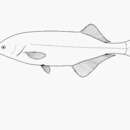Migration
provided by Fishbase
Potamodromous. Migrating within streams, migratory in rivers, e.g. Saliminus, Moxostoma, Labeo. Migrations should be cyclical and predictable and cover more than 100 km.
Biology
provided by Fishbase
In Lake Kyoga abundant among or near water lilies (Ref. 49805) and in Lake Victoria it occurs in shallow, inshore waters over sandy and rocky shores (Ref. 4903, 97924), seasonally over muddy bottoms adjacent to papyrus swamps or deep water near rocky islands (Ref. 9606, 97924). Feeds on bottom and in marginal vegetation; insectivorous (chironomid larvae, Povilla, Odonata larvae), but arthropods, oligochaetes and fish eggs are also eaten (Ref. 12526). Uses sensitive pointed addition to chin for testing holes in mud, papyrus roots and between stones to locate underwater insects (Ref. 36900). Rotates body to almost vertical position, searches substrate and grabs prey into mouth; produces weak electric organ discharge for navigation and to warn off other organisms (Ref. 97924). Oviparous (Ref. 205). Breeds twice a year during the rainy seasons, and migrates up rivers to spawn (Ref. 10608).
Importance
provided by Fishbase
fisheries: of no interest
Longnose stonebasher: Brief Summary
provided by wikipedia EN
The longnose stonebasher (Gnathonemus longibarbis) is a species of fish in the family Mormyridae. It is found in Burundi, the Democratic Republic of the Congo, Kenya, and Tanzania. Its natural habitats are rivers, freshwater lakes, freshwater marshes, and inland deltas.

Wikimedia Commons has media related to
Gnathonemus longibarbis.
 Wikispecies
Wikispecies has information related to
Gnathonemus longibarbis.
- license
- cc-by-sa-3.0
- copyright
- Wikipedia authors and editors

